. Arte Créative - Atelier A, Documentaire vidéo de 10mn - février 2017
. The Family of the Invisibles, France-Corée / Collection du Cnap / Séoul Museum of Art, 2016
. La Vignette - France Culture, Aude Lavigne, France Culture, 2015
. Où maintenant ? Quand maintenant ? Qui maintenant ?, Publication / Emmanuel Saulnier, Février 2016
. Art Press, Introducing par Anaël Pigeat, Février 2015
. Maculture.fr, par Wilson Le Personnic, Février 2015
. Inferno Magazine, Claque visuelle, par Christelle Granja, février 2015
. Toute la Culture, L’expérience ténébreuse de Rémy Yadan, par Camille Lucille Clerchon, Février 2015
. TÊTU Magazine, Tribunes Libres, Octobre 2014
. Yagg - YAGG TV, Interview de Rémy Yadan par Christophe Martet - Juillet 2014
. INFERNO, Magazine biannuel - Entretien de Rémy Yadan par Camilla Spizzichillo - Juin / Décembre 2014
. Jacques Damase au Pays du livre, Hommage à Jacques Damase par Rémy Yadan - rediffusion 2014
. Théâtral Magazine, Février 2014
. Rémy Yadan met les voiles, Le Télegramme, mars 2013
. Tamm Coat, mise à l’eau, Le Télégramme, mars 2013
. Rémy Yadan ; une culture ouverte sur le monde, Ouest-France, mars 2013
. De la pluridisciplinarité au travail de l’art, Séminaire, Villa Médicis avec Catherine Strasser et Yannis Kounellis, 2012
. Bee Jazz, Émission radio réalisée avec le compositeur Magic Malik, 2012
. Appuntamenti, Occupano / presse italienne, mars 2012
. Théâtre des expositions, catalogue de l’Académie de France à Rome - Villa Médicis, 2011
. Tableau de chasse, Émission radio réalisée avec la chanteuse-compositrice Claire Diterzi, 2011
. Aiguilles et bottes de foin, La Marseillaise, Denis Bonneville, oct 2010
. Wall painting, Émission radio réalisée avec le plasticien Kees Visser et le galeriste Jérôme Poggi, 2010
. Rémy Yadan, du plateau à l’écran, La Marseillaise, Denis Bonneville, oct 2010
. Le procès d’Oscar Wilde, Émission radio réalisée avec le plasticien Christian Merlhiot, 2010
. Madres, Turbulences vidéos, Numéro 64, Marianne Derrien, 2009
. Chronique, Émission réalisée avec le plasticien Clément Cogitore, 2009
. Kathy, Émission radio réalisée avec le plasticien Bertrand Lamarche et le critique d’art Guy Tortosa, 2009
. Projet avorté au 3bisf, La Marseillaise, 2009
. Réflexion bird, Émission radio réalisée avec le plasticien Cédric Eymenier, 2009
. (Not) a love song, Diaphora, Émission réalisée avec le chorégraphe Alain Buffard, 2008
. Tout contre… Rémy Yadan, Mouvement, Marianne Derrien, septembre 2008
. Confusion, Émission radio réalisée avec le plasticien Laurent Pernot, 2008
. Cruz Diez à Paris, Émission réalisée avec le plasticien Carlos Cruz DIez, 2007
. Je tu je, Émission radio réalisée avec la plasticienne Christelle Familiari et le galeriste Alain Gutharc, 2007
. Rémy Yadan, a blow to the heart, Frédéric Arends, Gus magazine, 08.08.2006
. Hologramme, Émission radio réalisée avec le plasticien et styliste Ali Mahdavi, 2006
. Les yeux de l’amour, Hervé Pons, portrait d'artiste, Têtu, 07.08.2006
. XXème Festival G&L, Catalogue de Turin
. Festival Underground de Lausanne, catalogue 2005
. Reporter, magazine portugais, 17.06.2005
. Tous les séïsmes, texte de Pierre Giquel, 20.03.2004
. A la frontière de la scène théâtrale, Midi libre, 19.04.2004
. Exposition Créteil Université, Le parisien, 08.06.2000
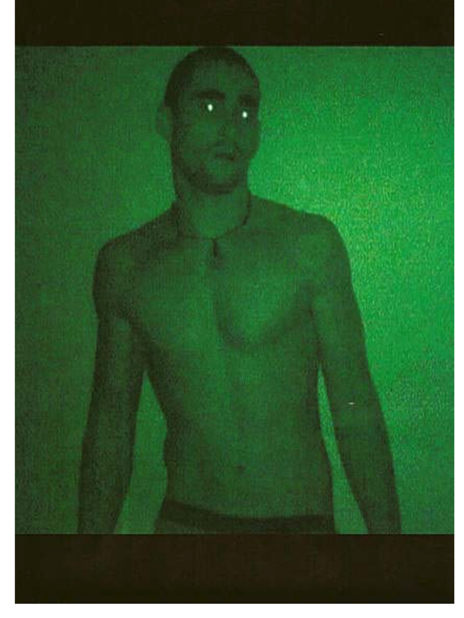
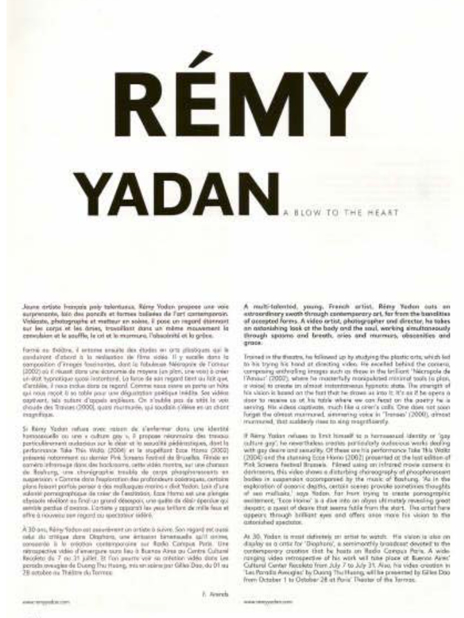
ART PRESS
As part of its Artdanthé festival, the Vanves theatre presents Fumeurs Noirs on 26 and 27 January 2015. This new show by Rémy Yadan, which was performed as a draft last year, is a journey through his Roman year spent in residence at the Villa Medici. It is an opportunity to take stock of a work that escapes definition, between the image and the stage.
The boundaries between the arts are dissolving today in favour of hybrid practices, nourished by collaborations and exchanges between disciplines; this is a subject we have mentioned several times in recent issues of art press. Rémy Yadan's work is radically in line with this perspective. He began his studies in theatre performance and then enrolled at the École nationale supérieure d'arts de Cergy where he was introduced to the medium of video. (1) It was from there that he developed his own work, which is now developing in two parallel directions: that of video, linked to the real, to intimacy and to a position of withdrawal into oneself in the making of images, and that of the stage, which is like a "rebound", a work linked to artifice, to the public sphere and to a form of collective effervescence. The medium seems to induce the subject. It is probably the questioning of the sacred that links these two paths, in a tension between the world of the everyday and that of myths.
INTIMACY OF IMAGES
Rémy Yadan's videos are meditative works, a practice apart. He works alone, both for the shooting and the editing. Some of them tend towards the documentary and the exploration of political and social issues, but they are always treated poetically, like inner journeys. In Madres (2006), for example, he evokes Argentina's political history through images of absence, the faces of the "Mothers of the Plaza de Mayo" in Buenos Aires, whose children disappeared during the dictatorship between 1976 and 1983. More recently, he has just shed light on a painful chapter of Italian history with Real Men (2014). The beauty of the Tremiti Islands on the Italian Adriatic coast contrasts terribly with their history; Mussolini had homosexuals deported there between 1928 and 1945. Religious issues are also among the subjects to which he often returns, for example in the video Je sais que tu m'entends (2009), a disturbing denunciation of the practices of a fanatical Argentinean church (the soundtrack of a ceremony is superimposed on images of passers-by in the street), or in Bois des fous, which shows a pardon in Brittany, a succession of images torn from reality, sometimes superimposed, and always out of time. It is rather to mythology that Du sang au cœur appeals, a short film of great violence, in which two peasants slaughter a rabbit; he wanted them to be animated like puppets by forces beyond them, those of destiny they say.
EFFERVESCENCE OF THE SCENE
Rémy Yadan is also a leader of men; since 201 1 he has directed the Tamm Coat company. A group of actors and singers who have been working regularly with him ever since. His shows are created from intentions that he proposes and adapts during rehearsals with his performers. He then draws a lot. If he often draws on literary or philosophical texts, it is to use them as a working tool with the actors. Some of these shows are more theatrical in nature, such as Nihil Obstat (2012), which is largely based on the Book of Job, and which was performed in Rome at the Teatro Valle Occupato, whose programme he had been entrusted with for a week (3). Others have a stronger plastic dimension, which places them more in the register of theatrical performance: in these, he sometimes plays himself.
These creations are often the result of a dialogue with a particular place. For example Movimento Parallelo (201 1), a recreation of his show Huitiéme de soupir (2008) for the Grand Salon of the Villa Medici. It was a challenge to the protocols of theatrical, state or religious representation. A sort of funny and poetic deregulation of the established order. Similarly, Héraclés (2012), created for the Herculean Room of the Farnese Palace, was based on a dialogue with the sculpture that gives it its name and with the architectural power of the place. A way of underlining the mortal posture of the man who tries to usurp an eternal image, as Rémy Yadan says.
It is also an existential quest that Fumeurs noirs (2014) stages. Unlike others, this show, whose title refers to underwater spurts that are at the origin of life on earth, is the dead-end vision of a life that is not yet known. It is the dead-end vision of a lost society, and the attempt of a burst of life, pleasure and liberation.
ALL EARTHQUAKES
By Pierre Giquel, writer, poet
Whether he practices video, photography or staging, Rémy Yadan likes nothing more than to enter into voluptuousness. With him, the mediums never cease to rub, to disoccupy their traditional task, to summon delights. The trance, which distances us from the theatre or rather from theatricality, appreciates the comic. It is therefore not surprising to hear Isidore Ducasse explain his conception of humanity through the voice and body of a young man. Like a chapter among others. The comic, far from all decorum, guides the monsters. Always lively, it knows how to fertilize flesh as well as graves. A show that is not haunted is of no interest, Jean Genet will have convinced us.
In Rémy Yadan's proposals, we accept all the earthquakes, the convulsions that roll around in the secret of bodies, souls and cries, we accept the shattering entrances as well as the indiscreet songs orchestrated by a voice, the Voice, that of the edges, that of the lover, sensual, Jewish. The theatre here is an open house. On the dance, this triumph with milk teeth. On the sound, the jaws have nothing to do with it. About the bodies, you slam as in the truth of love. On the man, young, between two caresses. On the corpse, this jubilation to see everything collapse, this so much pleasure, fear, dazzlement. Of incapacity, of lack where laughter sneaks in, of games played even when I climb onto the bed of my beloved dead, of my casual living, of my prized herbs, of my thought.
Pierre Giquel
TO THE END OF THE WORLD
By François Barré, president of the Tamm Coat company
Crossbreeding makes beautiful children. Rémy Yadan, a young French artist born of a Jewish Tunisian father and a Breton mother, is a shining example of this. Heir to different cultures and nourished by their confluence, he goes in search of the miracle of a first encounter. To be accomplished, this unceasingly renewed encounter must unite beings, enchant minds and bodies, arm a representation, travel on new paths, experiment.
Rémy Yadan knows how to order the text and the space, the play of bodies in movement and their alliance in a show with multiple resonances by calling on theatricality, the plastic arts, video, choreography, music and the fusion of these writings in a totality. Sometimes alone and other times supported by a group of actors, off stage or on stage in the clever machinery of a "performance", he is both a creator of live shows and a visual artist. To fully exercise this vast mastery, he needs a working framework that is commensurate with his scope and specificities. He therefore needs a theatre company; this is and will be Tamm Coat. We wanted to form this association in the most structured but free way possible and from the beginning we placed its development under the leadership of honorary members representing a range of experience and recognized authority. Born in December 2011, Tamm Coat, whose first national and international creations can be seen in the following pages, has a double objective. It affirms the theatrical and choreographic permanence of the dramaturgy, the scenography, the text, the acting, the set and the costumes, the performance as a construction and temporality, while referring to a renewal of the historiography of modern and contemporary theatre, as presented by Giovanni Lista in his reference work "The Modern Stage".
If the desire for experimentation is primary, it does not claim to be a break with the past, but rather a prestigious history marked by considerable creators who, from Futurism to the present day, from Artaud to Romeo Castelluci, have enriched the theatrical experience by inviting visual artists and/or modalities of visual creation to its celebration: John Cage, Merce Cunningham, Robert Rauschenberg, Carmelo Bene and Sylvano Bussoti, Tadeusz Kantor, Jerzy Grotowski, the Living Theatre, La Fura del Baus, Robert Wilson ... the "Physical Theatre" exalting the body, gesture and cry; the "Artist's Theatre" born in 1944 with the private performance at Michel Leiris' of Picasso's play "Le désir attrapé par la queue", then Ricardo Mosner, Michelangelo Pistoletto creating the "Zoo" theatre group, Janis Kounellis with Carlo Quartucci, Jean Dubuffet and his "Coucou bazar"... The quality of the actors brought together around Rémy Yadan, the diversity of their profiles and their artistic experiences, offer a real richness of interpretation.
For example, Diane Regneault, trained at the Théâtre National de Strasbourg, is both an actress and an author; Bénédicte Cerutti, who received the same training, has worked with Stéphane Braunschweig, Eric Vigner, Olivier Py, Frédéric Fisbach and Jean-Louis Martinelli; Gabriel Bestion de Camboulas, a pianist and organist, is the co-owner of the Ahrend organ at Lyon Cathedral. He has created several concert-spectacles combining video and dance, as well as "Aveugle Instinct" at the Opéra de Lyon. It is important to underline the loyalty to Rémy Yadan of most of these performers who, like Jessica Buresi, actress and singer, have always or most often worked with him and have become members of the association. Tamm Coat is a place of exchange, of common will, of play and invention.
The actors, dancers, musicians and visual artists form the very body of the group. It was urgent to structure this theatrical and choreographic work by creating this company after ten good years of directing. I remember the moving evening Catherine Strasser led me to at the Théâtre des Louvrais (Scène Nationale de Pontoise). Thirty actors were performing with fervour and passion a show by Rémy Yadan entitled Take this waltz. What we want today, as he continues to deploy his talents in France, Italy and Argentina, is to be able to give him the logistics, the foundation and the means of a young, enthusiastic, fusional company with a burning desire for movement, challenges and experimentation. Tamm Coat Studio will go to the ends of the earth.
François Barré
1- Giovanni Lista - La Scène moderne, Encyclopédie mondiale des arts du spectacle dans la seconde moitié du XXème siècle -
Editions Carré and Actes Sud 1997
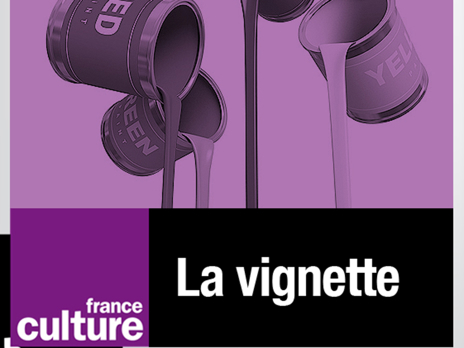

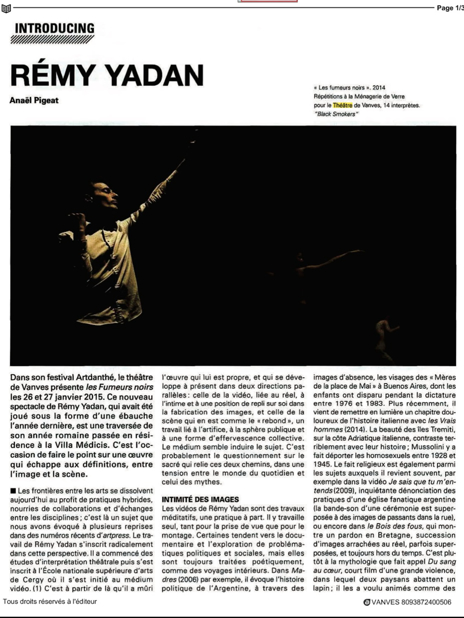
TÊTU MAGAZINE
Rémy Yadan has a small house in Brittany, facing the sea. He likes this solitude, retreating there, taking the time to step back and conceive his projects. However, the boy is not at all a soft contemplative, he is a voluble, charming and charming person, who likes to wander on the crossroads of contemporary art. Videographer, director, performer, writer, if he gives the impression of touching everything, the poet with soles of wind builds a dense, lyrical work, with expressionist and romantic accents with this question tied to the body: how to live? My videos are the result of an anguished secretion," he explains. There is something of the order of an existential quest.
Of loss too, of recognition, of wandering, of feeling... Like one of his films, Ecce Homo, about the world of backrooms, which has been screened throughout Europe at gay and lesbian festivals and in art galleries. "I've made about fifteen films, this one is the trashiest I've made. However, for me it is a sentimental film. If there are sex scenes, they are accompanied by an extremely poetic text by Bashung that "sentimentalises" the images. It's a totally subjective film. There may be a festive side to the backrooms, but Ecce Homo flirts with the idea of despair. It is neither an apology for a certain sexuality, nor a social critique. Moreover, it ends with a quote from Cocteau about Genet: "You have to admit that he's a moralist! The ballad is sulphurous, but Ecce Homo exudes immense tenderness, a feeling of total abandonment, of loss of identity. As is often the case in Remy Yadan's work.
Some of his works created during a working residency in Argentina will be presented this summer in Buenos Aires as part of a large exhibition. "In Buenos Aires, I made a video, Madres, because I was shocked by the tourist attraction around the weekly demonstration of the mothers and grandmothers of children who disappeared during the dictatorship. The pain, the lust, the empathy, the voyeurism, the endless photographs are all staged. It was like a fair. So I made a video only about the spectators. "In addition to his own videos and performances, Rémy Yadan also works with the visual artist Fabrice Hyber, with whom he produced an artistic document in Seoul entitled De la vaiselle et des dents, and more recently with Alain Buffard, whose Les Inconsolés he filmed for Vidéo Danse. If, for Rémy, sexuality is not an identity, the little guy from Créteil claims that it is at the heart of his work. Beyond that, it's love he's talking about. Of tenderness too.
Hervé Pons
Photo of Benni Valsson
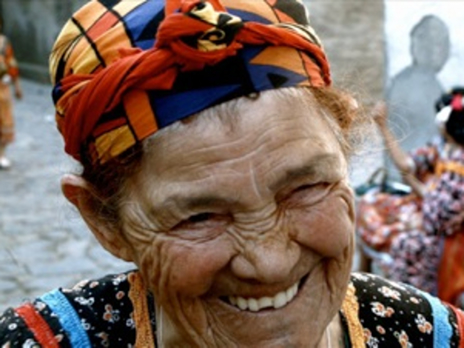
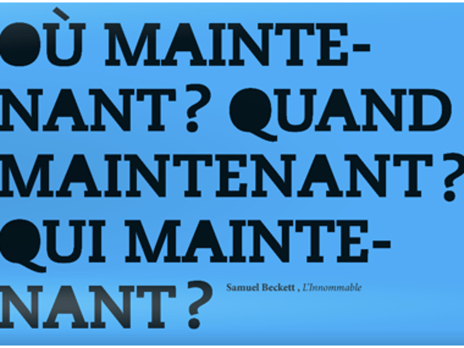
LA MARSEILLAISE
Rémy Yadan, from stage to screen
A graduate of the Ecole nationale supérieure d'art de Cergy, the video artist and director Rémy Yadan has had several residencies at the Recoleta Cultural Centre in Buenos Aires, where in 2006 he presented a solo exhibition entitled Hora sideral, and at the Cité internationale des arts in Paris, where in 2008 he directed several productions, while his videos were shown at international festivals (Brussels, Lisbon, Lausanne, Turin, Madrid, Buenos Aires, etc.). He directed Alain Buffard's choreographies Les In and (Not) a love song, which were screened at Vidéodanse at the Centre Pompidou in 2006 and 2008. At the same time, since 2004, he has been offering a monthly radio programme in Paris devoted to contemporary art. Diaphoraccords. and has just obtained a one-year residency at the Villa Medici in Rome, where he will reside from April 2011 to April 2012; an approach that led him, last season, to direct theatre workshops in the psychiatric hospital of Aix-en-Provence, at the invitation of 3bisf; a residency that, for reasons of personal incompatibility, could not come to fruition; together with the workshop participants, we did not want to leave this project without follow-up: It wasn't easy, but we managed to do it "Sur le vif d'une vibration".
Hosted by the Point de bascule, rue Breteuil, Rémy Yadan and his actors, both professionals and amateurs, will present tomorrow and Saturday the show Tout va le mieux que il soit possible. The result of improvisations, like a "rudimentary play written collectively on the spot of a human, physical, spatial, gestural, textual and musical vibration, based on the themes of confinement, whether it be amorous, psychological, emotional, medical or political. Cloistering, isolation, inability to communicate: from this a priori dark base, the workshops revealed, according to him, a brighter side: "Naturally, funny and offbeat moments, which were necessary, came to defuse the seriousness, without Vannuler explains. It is the result of a sensitive, complicit and frustrated theatrical research by a group of performers who give themselves up to the obvious in all simplicity, he concludes, anxious not to reveal too much about the content of this theatrical object inspired in particular by a sentence extracted from La trilogie du sacré sauvage by the journalist and writer Virginie Luc: "To call us a monster or an angel is to formulate the same insult. It is to relegate us, in both cases, to the outside of the world.
Each evening will be followed, around 10pm, by a series of screenings of Rémy Yadan's films. Films that were initially to be hosted by the neighbouring Montévidéo, which had to close its doors temporarily for security reasons.
Denis Bonneville
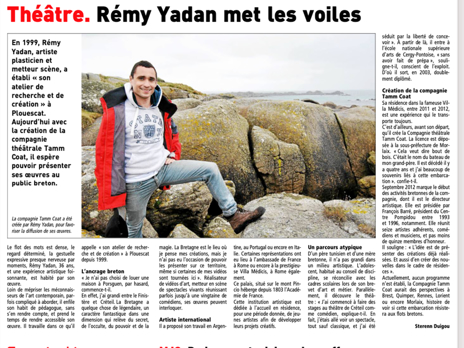

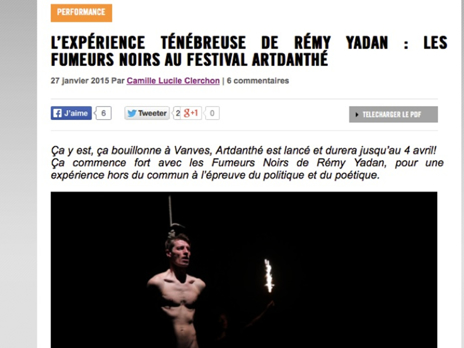
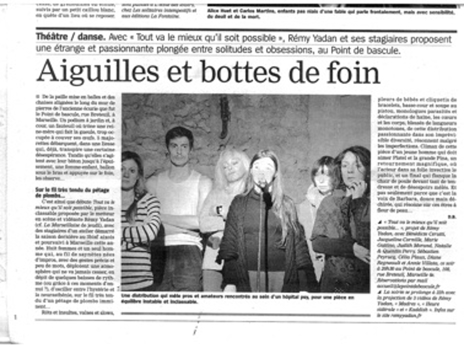
GUS MAGAZINE
Rémy Yadan, a blow to the heart...
A young and talented French artist, Rémy Yadan proposes a surprising path, far from the preconceived notions and forms of contemporary art. Videographer, photographer and director, he takes an astonishing look at bodies and souls, working in the same movement the convulsion and the breath, the cry and the whisper, the obscenity and the grace. Trained in theatre, he then began studying visual arts, which led him first to the making of video films. He excelled in the composition of fascinating images, including the fabulous Necropolis of Love (2002), in which he succeeded in creating an almost instantaneous hypnotic state with an economy of means (one shot, one voice). The strength of his gaze lies in the fact that from the outset he includes us in his gaze. Just as a host opens his door to us and welcomes us to his table for an unprecedented poetic tasting. His videos captivate, like so many enticing calls. We do not forget the warm voice of Transes (2000), almost whispered, which suddenly rises into a magnificent song. Although Rémy Yadan rightly refuses to confine himself to a homosexual identity or a "gay culture", he nonetheless proposes particularly daring works on pederastic desire and sexuality, including the performance Take This Waltz (2004) and the stunning Ecce Homo (2002), which was presented at the last Pink Screens Festival in Brussels. Filmed with an infrared camera in backrooms, this video shows a disturbing choreography of phosphorescent bodies in suspension to a Bashung song. "As in the exploration of the ocean depths, some shots are reminiscent of marine molluscs", says Yadan. Far from a pornographic desire to create excitement, Ecce Homo is an abyssal dive revealing in the end a great despair, a desperate quest for desire that seems lost in advance. The artist appears with his eyes shining brightly and offers his gaze to the stunned spectator once again.
At 30, Rémy Yadan is certainly an artist to watch. He is also a critic for Diaphora, a monthly programme devoted to contemporary creation on Radio Campus Paris. A major video retrospective will be held in Buenos Aires at the Recoleta Art Centre in July 2006. And his video creation will be shown in Les paradis aveugles by Duong Thu Huong, directed by Gilles Dao at the Théâtre du Tarmac in September 06.
F.Arends
Belgian magazine "Gus" published in July-August 2006


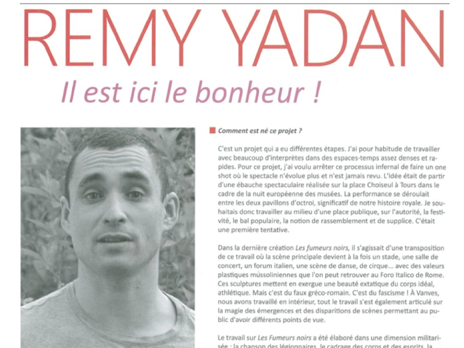
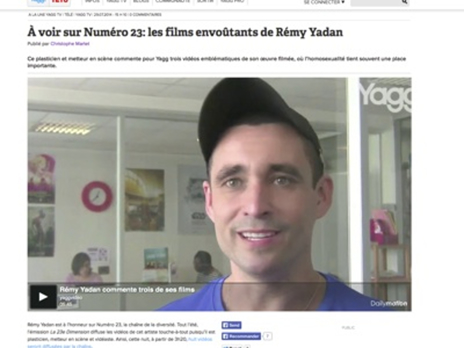
ALL CULTURE
As soon as we enter the room, we feel the darkness, which is particularly dense, but still bright enough to understand that we will not be offered a seat. We, the spectators, form a vacant herd, perhaps slightly worried, which spontaneously gathers in the centre of the room. From the shadows, figures emerge on numerous podiums that surround us. We never know where in this circle the action will take place, and remain in a climate of anticipation that makes this experience a real collective adventure. From the darkness arise multiple foci; we are confronted, as a mass making, in fact, collective, with a set of propositions that arouse emotions and reflections: surveillance, punishment, sacrifice and cruelty as founding notions of societies. Martial patriotism is put on the stage, mixed feelings in these times when values seem to be reconfigured, like a plate tectonics with an uncertain outcome.
Then, at times, real moments of dance come to express the inalienable freedom of the bodies, the songs and choreographies colour this troubling experience with joy, lightness but also vanity.
The Black Smokers are geological formations located deep in the oceans, where there is no more light, a kind of volcano from which burning fluids escape, in a way, the excess heat of the Earth.
This title, and the images it conveys, is a guiding thread for a global device within which a fragmentary proposal with multiple references develops. If the writings of Michel Foucault and Walt Withman are called upon, it is more of a sensory and emotional experience that treats the texts for the evocative powers of the words rather than to support a constructed philosophical proposition. It is therefore a question of letting oneself go to a possibly cathartic experience.
Rémy Yadan's proposal calls for performance, theatre, dance and installation in a remarkable hybridity of disciplines. Enveloped in the singular atmosphere of a very powerful visual and sound universe, standing as in an exhibition, but facing bodies delivered without restraint as in a dance performance, and with actors who give body to texts, there is in Les Fumeurs Noirs a rare, humble and brilliant syncretism.
Les Fumeurs Noirs by Rémy Yadan: from 26 to 27 January 2015 at the Théâtre de Vanves
Full programme of the Artdanthé festival: http://www.theatre-vanves.fr/discipline/artdanthe/
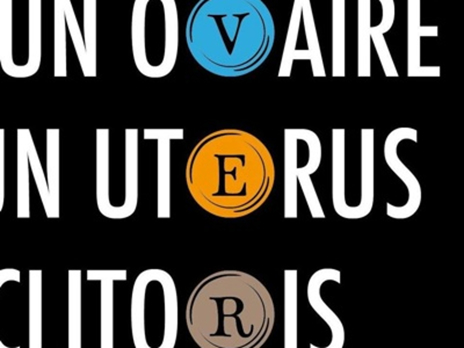
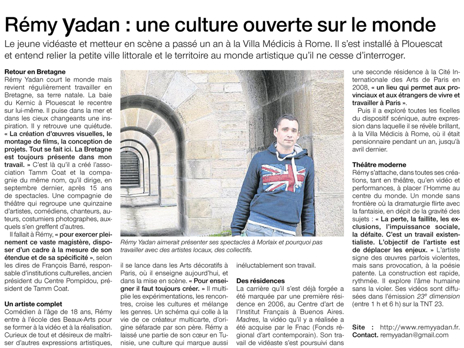
Two unworthy old ladies?
By Eric de Chassey
Published: 25/03/2012
The alliance between the Villa Medici and the Valle Occupato may seem unnatural. In reality, it simply stems from the need for this place maintained by France in Italy to maintain a privileged link with the most vibrant and innovative cultural realities of the country that hosts it. I like to think of it as a bit like the friendship of two old and somewhat unworthy ladies: one, the theatre, which is currently enjoying a new lease of life; the other, the Villa, which has been constantly renewing itself ever since, in its sixteenth-century buildings and gardens, it brought together the best creators and researchers from all disciplines, united by the same dynamic conception of culture. The initiative came from these resident artists (as they are called). They are the ones who have established links with their Italian counterparts and who have found themselves programmers of the occupied Valle, for evenings of poetry, theatre, dance, performances and debates. They were the ones who invited some particularly interesting French artists to come to Rome, without a fee. (...) But I know that here in Rome there is real hope for culture in Europe. It is very exciting that this hope comes from the country that seemed to have gone the furthest in rejecting non-commercial culture, from the country whose leaders - at the forefront of many of their colleagues, unfortunately - proclaimed that culture was nothing more than a rather chic front for tourism and events. This experience is a fundamental work, based on the idea that culture is a common good, which can and must therefore escape the rules of profit, if not of the market: a work that is certainly particular but truly exemplary. "How sad is prudence!
IN GENTLENESS AND FEROCITY
CATHERINE STRASSER - REMY YADAN
Laura magazine / October 2013 - March 2014
(Magazine available in art centres)
A look back at Rémy Yadan's work after his exhibition Survivances at Eternal Gallery (May-July 2013) and the performance of the company Tamm Coat (18 May 2013, Place Choiseul in Tours), organised by Eternal Network. He will be in residence at Volapük, Tours, in November 2013.
This time we begin an unusual conversation, after all the words we have already exchanged: we will have to fly over Europe to connect the centre of France to the Turkish coast, the places of our current work. Our migrant origins will allow us to gather the pieces still waiting to be put together. This dispersed situation corresponds perfectly to the first perception that your work can produce: a disparate assembly of forms, themselves composite, so varied that I can initially approach them by what separates them. What you have been developing over the last fifteen years has nevertheless been very coherent and easily distinguishable from other contemporary practices. However, you seem to build on schizophrenia, paradoxes, vertigo, in your inspirations as well as in your achievements. Perhaps you work on your pieces like a trainer with his animals, between two alternatives: gently or ferociously - as the language of the circus says.
To begin with, your production can be divided into two groups of works: video films on the one hand and theatrical performances (you will come back to their definition) on the other. So you present yourself as a visual artist and as a director in the broadest sense, since you are also an author. What motivates the choice of one expression or another in your creation?
Two main fields of action have indeed been defined over the years. That of the moving image and that of directing. I had a rather theatrical background before entering the Ecole Nationale Supérieure d'Art de Cergy. There, during my years of study, I became involved in video creation and I also took advantage of my interpretive skills to develop my first theatrical performances within the school itself. I involved many external actors in these more or less public events. The term "theatrical performance" is not really definitive, even though at that time there were already obvious references to the visual arts which were mixed with those of the performing arts, whether theatrical or choreographic.
Having subsequently developed a loyalty to these two modes of research and work, I was able to define my artistic identity on these two complementary poles, as a visual artist cultivating video and staging.
Obviously, the relationship to these two media does not at all federate the same issues, neither in the elaboration of the approach, nor in the result. To understand what characterises these two choices, I must perhaps first understand what differentiates them.
On the one hand, in my video works, I often work alone, both in the shots generally taken on the spot and in the editing, whereas in the stage set-up, the building of the plastic research and improvisations are usually the result of a physical and textual dialogue, which I conduct in rehearsal, with a large number of actors, dancers, singers, musicians and sometimes performers.
On the other hand, the relationship to temporality is imposed with a notable distinction. Video work defines a form and freezes it in its own finality, whereas in theatrical performances the immediacy of the event and the spaces in which I intervene are more decisive - these values are inherent to the history of Performance. So what motivates my choice, in one expression or the other, is deeply linked to what both engage.
I also distinguish two approaches. One, contemplative, puts the spectator in a meditative state, facing very slow phenomena, often linked to the landscape and its observation. The other, overexcited, excites the nerves and mobilises the attention by the profusion of events and their explosion in space, by their almost convulsive expression. Are they independent of the type of medium, film or show? It's difficult to generalise with you, but I seem to encounter more the meditative part in films and the convulsive part in certain shows. Do you recognise this distinction?
I would tend to favour a fictional, eruptive and frenetic poetic sense in the live dimension of the performances, whereas in my video productions I would be more likely to spread an introspective, collected and exalted content. Indeed, there is sometimes a clear distinction between impetuous stagings and videos, but it is relative and can be erased. In the field of the performing arts, for example, the orchestration of my teams galvanises in me the primary necessities of creation; the relationships of force, the losses, the attempts, the incapacities, the derelictions... All these tests of audacity and freedom are amply translated into scenic virulence, physical affronts and human shaking. There is an urgent and immediate feeling that comes over me in my productions. Everything is fundamentally urgent. This component therefore sometimes takes on seismic and scattered forms, more excessive and more enraged. Even if my shows as a whole may seem desperate, there are also engaging graces, tender ironies and happy poems in the treatment of these writings.
My devices are based on spatial splits. As far as possible, I invest the entirety of the space, the stage and its surroundings, the heights, the operational perspectives, the recesses, the folds... a complete reappropriation of the architectures, which sometimes gives rise to a different grip on the audience, a seizure of the spectator.
In short, I deploy my performative and theatrical creation in three real and physical dimensions, which I naturally cannot achieve in my image work. In my video designs, I take my time, I put down the rushes and I decant alone. The contemplative notion is strong and recurrent. Our place in the world, the question of our survival, is assured by our social environment of course, but also by our geographical environment. The power of the natural elements is a recurring theme in my visual preoccupations, such as the ocean's fervour (L'offrande, 6mn, 2001 or Ravin bleu, 10mn, 2008) or the immensity of sandy areas (Kaddish, 10mn, 2012), everything that can annihilate us, which implicitly puts our intrinsic powerlessness in its proper perspective.
In all cases, rhythm is a determining factor, whether slow or fast, whatever the medium. It presides over the editing of films as well as the editing of scenes in shows. You can produce it through a technical effect (such as slow motion) but also through observation, or through the simultaneity of the actions of your actors. How do you work with rhythm and its variations?
Rhythmic discernment is a real work of composition. In one medium as in the other, I organise time subjectively, seeking acuity, sensitivity and alternation through phenomena that are sometimes slow and measured, or sudden and precipitous. I mainly favour short, effective forms. The dramaturgical scope is at the very heart of these elaborations. I obviously have no fixed rules on this subject, each work has its own virtues and contradictions. Despite all that I can say here, I do not know what my next productions will be made of. I am therefore not looking for a system in which I will unfold my work based on pre-established conceptual structures. I can only try to discern the content of the works I have made in the past, without taking them apart. I think, however, that the rhythmic variations attest to possible stage ambushes or sometimes scandalize emotional reversals in my video productions.
At certain moments, when the rhythm is born from an action, you can prolong the physical performance to the point of exhaustion. What are you looking for then?
Indeed, this has happened in various spectacular pieces. To simplify things a little, the physical exhaustion of a performer on the stage is often motivated by a counter-field / counter-point on the stage where an imperturbable immobility is at stake, for example. It is the performative character that becomes central to this type of experimentation. Bursts of reality and sincerity, a gift of the body at the limit of play and control. It's a delicate border. At these precise moments, I don't direct my actors by exhorting them to act but rather to do. This is perhaps the crux of my theatrical performances: to stage a physical veracity, an action, a reality that is more akin to the visual arts, while considering the light and/or music envelope (if any) in a completely assumed spectacular climate.
You produce sound like most of the texts of your plays, whether filmic or theatrical, and you mix quotations that are so numerous but also so varied that their assembly is surprising, even to the point of blurring them at times. In addressing this question I also touch on the area of your references: some are occasional, others recurrent. What motivates you?
In the field of references, how do you wish to inscribe yourself artistically? Which creators do you feel close to? Does admiration play a role?
I produce the sound for a few video pieces, but in my productions I use music that can clash with the actors' performance. The musical eras and registers are discordant. Through these diversified sounds, I open up unexpected perceptions by escaping visual and sound coherence. It is difficult for me to know exactly how and where this or that work affects my work. This being the case, we know full well that we are also forged by striking aesthetics. I am thinking of the paintings of Caravaggio, Richter, the performance exhibitions of Brett Bailey, Adrien Paci, Christoph Schlingensief, the shows of Romeo Castelluci, Jürgen Gosch, Angelica Liddell, Pippo Delbono, Pierre Meunier or Yves-Noël Genod, the music of Ellen Alllien, Magic Malik, Koudlam, Broadcast, Plannigtorock, J.S. Bach or Brian Eno. I can't forget to mention Fellini and Pasolini.
In your own pantheon, I recognise two lines: one burning and the other icy, the baroque and the classical, lyricism and construction, improvisation and mastery...
Yes, these assemblies of emotional and/or plastic shocks also contribute to my evolving research and to the overall path of my approaches.
The works of artists mentioned above have had tangible effects on my artistic vision. Admiration can strengthen my faith in creation. It can also inflame my desire to work, set my aspiration ablaze, fan my appetite. The trick is to digest these impulses well in order to feed new creative forms, while always remaining aware of the influence of these works in my production tools. This is the complexity of creation.
To stay with the opposites, two types of inspiration stand out in your work. In one, almost documentary, you place yourself as an observer of natural phenomena or social events. The other, on the contrary, shows a fascination for what has been called the great narratives: mythology, the Bible, sometimes also history. How do you explain your attraction to such distant subjects?
It seems to me that the whole of humanity is founded on the very basis of the great narratives. This may explain my attraction to social subjects as well as to mythology or the Bible. You can't understand your contemporaries without taking hold of history. In a certain way, my last two shows reflect this failure of the human race. I tackle the same suffering, the same injustices and the same torments by working on the Book of Job (Nihil obstat, staged in Rome when I was a resident at the Villa Medici) as on contemporary texts such as Michel Foucault's Surveiller et punir (Il est ici le bonheur, staged in Tours, as part of the last European Night of the Museums by Eternal Network).
In all plays, from the most documentary to the most imaginary, there is a theatricality that does not depend on the subject. So you can give the most everyday, the most trivial gestures a form of ritualisation. But also the theme of ceremony, real or staged, comes up regularly in your work. Is it a fascination with the ritual form? Or a certain sense of the sacred?
The sacred dimension of my work is very present. Whether it is blatant, authentic or hidden in the everyday. From this, ceremonial variants arise that enchant me. I am always very moved by the theatricality of the religious, of celebrations, of processions, of all these solemnities that disconcert and move me. The moral impregnation of the faithful, the appearance of the subjects, their conviction, their custom, their history, their weight, their endurance, their determination and above all their belief, are strong emotions that suck up part of my work. The documentary video works Madres 13mn, 2006 and Je sais que tu m'entends 14mn, 2009 (made in Argentina) or Le bois des fous 22mn, 2011, testify to this. I have shown a real religious and political immersion for the realization of these images, essentially torn from reality.
The role of men and women is sometimes abused or treated in a violent way in your shows in particular. The question of sex is omnipresent. Can you clarify your position?
In my early years, I was experimenting more with the fury of the performers and the sometimes libidinal behavioural disturbances, but I would more easily speak of sensuality and eroticism than sexuality. One way of seizing the limits and maintaining a form of belligerent confrontation with the audience is the eternal arm wrestling between the show and the audience. These tendencies are not imperative and are becoming less and less common in the conduct of my research. This crossing was certainly essential for me to apprehend a working space without too many constraints, a way of gaining freedom by evacuating the limits. Having said that, I would like to say that no one was mistreated in my shows! Some violent scenes were artificialized by a distanced and theatrical interpretation.
Roles or scenes that convey ferocity are often part of the stage boil of an emotional or sentimental exclusion. This is a range that is integral to my stage writing. Why exclude these distressing observations from my work? Of course I don't stage pain, but it seems to me to be important not to blindly discard conflict. The world is not peaceful. It is full of harshness, excess, insanity, oppression and uprisings.
My art work, while poetic, also abounds in cry and revolt.
Assos, Turkey - Saint Marc du Cor, France, August 2013
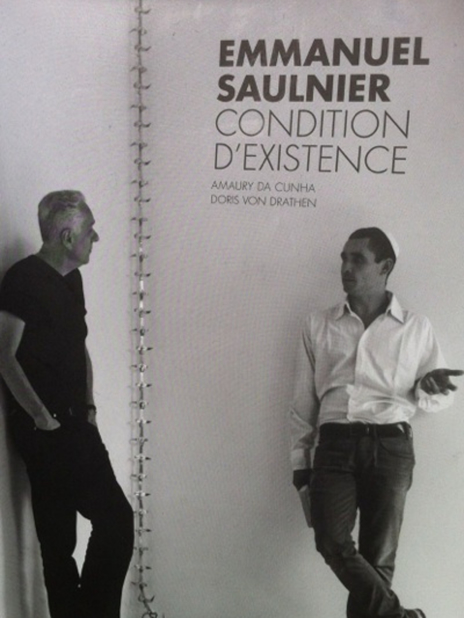
WITH RÉMY YADAN, EVERYTHING IS SIMPLE
There are images of the sea, the breath of a runner, an immodest woman, a sweet song sung by the author himself in his naked and touching fragility. Richard Squires is something else, and yet he shares with Tom de Pekin and Rémy Yadan the charm of spontaneity staged with rigour and sometimes with the greatest zaniness, an influence, no doubt, of comics and video games. His work is just as subversive despite its air of not touching. He is perhaps the craziest of the three and I like that.
As you can see, this programme is an evening programme because it is made of desires, fantasies and bewitching night club music.
Unglee, 19 August 2005